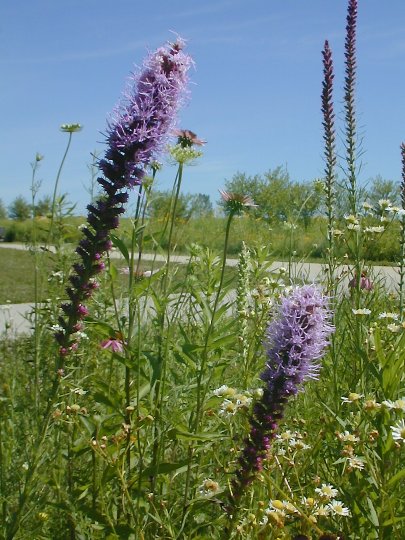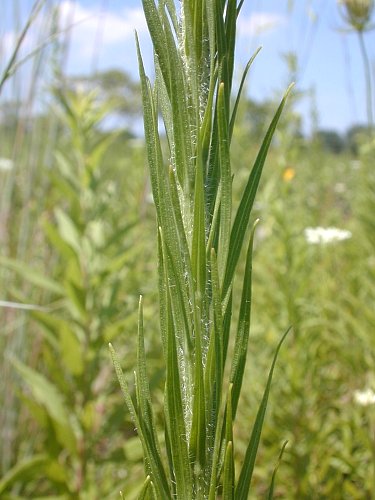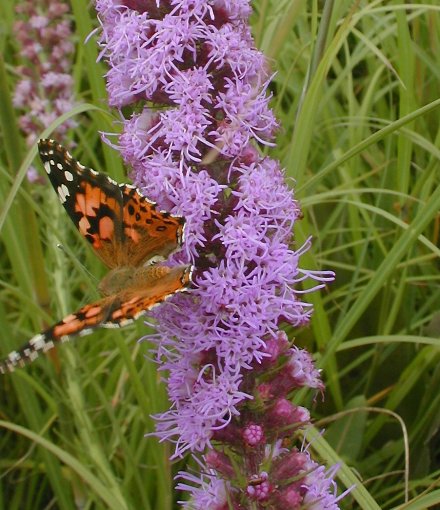Description: This herbaceous perennial plant is up to 4' tall and unbranched. The central stem is fairly stout, with numerous small longitudinal ridges. It is usually covered with scattered white hairs. The leaves near the base of the plant are up to 10" long and ½" wide, but become progressively smaller as they ascend the stem. They are linear, and quite numerous as they alternate around the stem. Their margins are smooth, and each leaf has a prominent central vein. The underside of the leaves and the central stem are sometimes whitish green in appearance. The central stem terminates in an inflorescence that consists of a long spike of sessile flowerheads. The flowerheads individually have 5-10 pink to purplish pink flowers. Each flowerhead is about ¼–½" across and subtended by green or reddish bracts whose tips recurve sharply outward. Each small flower has 5 lobes that spread outward from the corolla tube, from which emerges 2 long curly styles. There is no floral scent. The blooming period occurs during late summer and lasts about a month. Afterwards, achenes form with light brown tufts of hair, which are distributed by the wind. The root system consists of corms, which occasionally form offsets near the mother plant.

Cultivation:
The
preference is full sun and moist to mesic conditions. Established
plants can tolerate some drought, but seedlings and transplants are
vulnerable. The soil should consist of a rich loam or clay loam, and
can contain rocky material. There is a tendency for the lower leaves to
turn yellow and wither away if conditions become too dry. During the
first year, this plant may develop slowly and prove temperamental, but
once established it is easy to maintain. This blazingstar remains
reasonably erect, even when spoiled in a flower garden, but may bend
around oddly if there is significant obstruction of sunlight.
Range & Habitat:
The native Prairie Blazingstar occurs in scattered counties of
Illinois; it is
less common in western and southern areas of the state (see Distribution
Map). This plant is sometimes locally common, particularly in
high quality habitats, otherwise it is uncommon or absent. Habitats
include moist to mesic black soil prairies, moist meadows near
woodlands or rivers, limestone glades, rocky bluffs, and areas along
railroads.

Faunal Associations: The flowers are pollinated primarily by long-tongued bees, butterflies, and skippers. Other visitors include Halictine bees, bee flies, and day-flying moths. Among the long-tongued bees, are such visitors as honeybees, bumblebees, Little Carpenter bees, Miner bees, and large Leaf-Cutting bees. Butterfly visitors include Monarchs, Swallowtails, Painted Ladies, Sulfurs, Whites, and others. The caterpillars of the rare Schinia gloriosa (Glorious Flower Moth) feed on the flowers and seed capsules. Various mammalian herbivores readily consume Prairie Blazingstar. Younger plants may be eaten by rabbits and groundhogs, while mature plants are likely targets of deer or livestock. Small rodents, such as the Prairie Vole and Meadow Vole, sometimes eat the corms. An overpopulation of these animals can make establishment of this plant difficult in some areas.

Photographic
Location:
The photographs were taken at Meadowbrook Park in Urbana, Illinois, and
Loda Cemetery Prairie in Iroquois County, Illinois.
Comments:
This is a beautiful plant that resembles a fairy wand. Prairie
Blazingstar can be readily distinguished from most other blazingstars
by the sharply recurved bracts subtending the flowerheads. Other
species usually have smooth, straight bracts that vary in their shape
or hairiness. The size and showiness of the flowers can depend on the
local ecotype. There are some wild populations of plants with white
flowers, although they are rare. This plant blooms after Liatris
cylindrica (Cylindrical Blazingstar), but before Liatris
aspera (Rough Blazingstar).